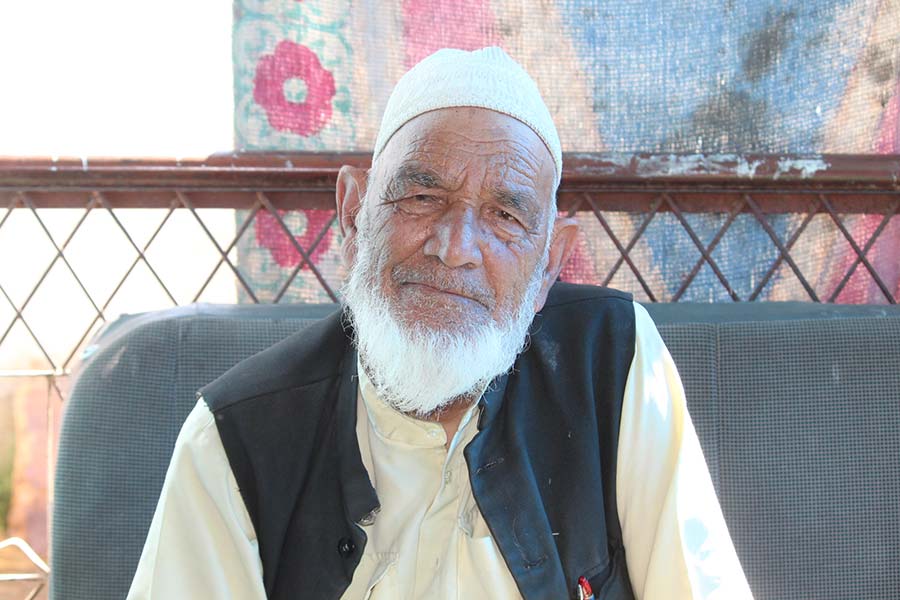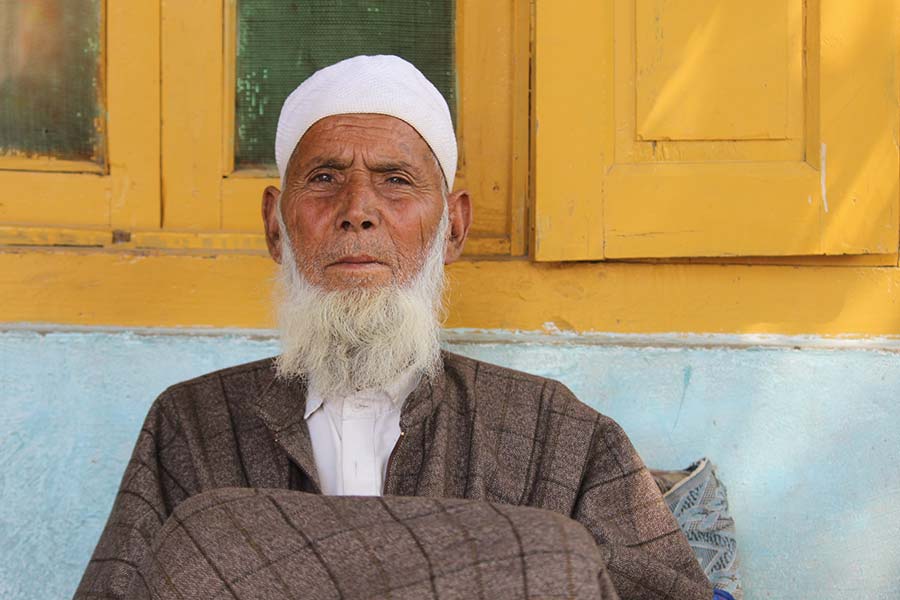The follow up to 1931 upheavals in Kashmir are scattered and sketchy. Almost 500 people were killed across Kashmir in the protests that erupted after the July 13, killings outside the central jail Srinagar. Javid Sofi locates some witnesses and rediscovers the Pulwama massacre that happened two months after the popular Martyrs’ Day

“Soon after killing two persons and injuring dozens in Shopain town on September 23, 1931, Hari Singh’s Dogra forces launched an intense search operation in Pulwama,” recalls Mohammad Khalil Ganie 96, a resident of Washibugh, Pulwama.
Ganie has witnessed the events which unfolded in Pulwama in the aftermath of the July 13, 1931 massacre in Srinagar. A house to house search was launched in Pulwama by Dogra forces for a Shopian resident, Khalil Banday, who was wanted for revolting against and thrashing a court official of Hari Singh at Shopian, Ganie said.
“Soon after killing two people and injuring dozens in Shopian town on September 23, 1931, Hari Singh’s Dogra forces launched an intense search operation in Pulwama,” recalled Mohammad Khalil Ganie, 96, a resident of Washbugh, Pulwama.
Dogras’ suspected Banday was hiding in Pulwama so the town was put under Martial Law. During searches, they committed atrocities against the residents. Ghulam Ahmad Haji and Abdul Gaffar Sheikh, residents of Washbugh, were severely interrogated. They were whipped on mere suspicion of knowing Banday’s whereabouts.
This agitated people forcing them to come on roads. People from different villages of Pulwama took to the streets chanting slogans against the Maharaja.
“Around 4,000 thousand people assembled at then Buin-e- Bagh (Chinar garden), which nowadays is known as Shaheed Park (martyr’s garden),” recalled Ganie.
Mohammad Abdullah Thoker, who claims to be a centenarian, is a resident of Gudoora, a habitation around 3kms from the town. “Around 400 people from Pinglina, Uricherso, Hanjikhulu, Ratnipora, Barpora and other surrounding villages took out a protest rally which merged with protestors who had already assembled near the Boun-e-Bagh,” Thoker said.
Thoker, then 18, followed the protestors. He said the majority of the protestors were from Uricherso, led by a well-built man, Mohammad Munawar.
“Dogra forces tried to disperse the protestors but they were overpowered and pushed back to a police post which was located in a building which houses today’s Tehsil office,” recalled Ganie.
Those days, the police post was named as Tazeer-e-Choeek. Both these aged residents said that the protestors started raising slogans against Maharaja and marched towards the post, not far away from the Buin-e- Bagh.
“They pelted stones on the Dogra forces, as was the norm, those days. Some stones hit a window glass of the building which was housing the police post, creating a hole in it,” said Ganai.
Many policemen were guarding the post, but authorities ordered a cop to open fire on protestors. A police constable aimed his rifle through the hole at protestors from within the building and fired indiscriminately. Many were killed and injured in the firing.
Ganie said that 13 people were killed in the firing but he had witnessed only two protestors collapsing before his eyes. Ghulam Mohammad, a tailor from Gund-i-Haider, a habitation in the vicinity of Washbugh, was hit near the graveyard, few steps from the police post. “A bullet pierced his throat and he died on the spot. He was around 30.”
A pedestrian, who was later identified as a resident of Chrar-e-Sharief was passing on the rear side of the police post when he was hit by a bullet. “He was killed in a target fire. After piercing his abdomen, the bullet hit a Chinar tree,” Ganai said.
Ganie’s elder brother Ghulam Mohammad Ganie, who has already passed away, rushed to the scene and retrieved the injured after carrying them on his shoulders. He bandaged his wound but couldn’t save him from collapsing. This resident from Chrar-e-Sharief is remembered by locals as Mohammad Sultan Tota, who was buried near the spot where he fell to bullets. “For two days the bodies were kept at the police post because villagers were so scared that they didn’t come forward for identification,” Ganie said.
Thoker recalled that after the firing roads leading to Pulwama looked deserted.
“Nobody mustered the courage to stand there,” he said. In the afternoon that day, he said, they received the news that Mohammad Munawar had fallen to bullets. His death came as a shock not only for his family members but for people of the entire area because he had established himself as a fearless person among villagers. “Many villagers from Uricherso and Pinglina rushed to claim his body but none gathered the courage to go near the police post,” Thoker said.
Dayim Mohammad Bhat, a centenarian from Prichoo village had revealed to this reporter, before he passed away in 2015, that 17 people were killed and dozens were injured by police firing on protestors in Pulwama. The massacre, he said, took place within a week after the Shopian killings. He also said that after the incident Pulwama was put under curfew, the corpses were lying in the Chinar garden for three days after which a group of youth were allowed to lift the bodies and bury them near the central mosque in Pulwama. It was after this massacre that Chinar garden became popular as Shaheed Park Pulwama.

The worst, however, was yet to come. The Dogra forces intensified searches for those who had participated in the protests against them. Fearing humiliation, many residents of Pulwama and adjoining villages went into hiding.
“Mohammad Sultan Nengroo and Abdul Gaffar from Prichoo village were arrested. They were subjected to brutal torture in the police station. These two residents were tied to a wooden frame by ropes and then whipped until they fell unconscious,” Bhat had told me.
When some degree of normalcy returned, residents of Pulwama were asked to pay Rs 15 as fine for breaking window panes of the police post. Abdul Rashid Mir, a shopkeeper in the main market Pulwama said Rs 15, then, was a huge sum and no one had the capacity to pay it by himself so contributions were asked from all households in Pulwama.
Mir said that none mustered the courage to challenge the dictate of Dogras’ except a pious old woman, Noor-e-Ded, his great grandmother, who refused to pay even a single penny to them.
The aged residents find it difficult to recall the names of all persons who were killed here in September 1931. “Three of them were from Pulwama town,” said Abdul Samad Dar of Prichoo, who claims to be 120.“One among them was Ghulam Rasool’s son. He was very popular among locals for his good looks.”
Historian Muhammad Yusuf Saraf, however, has referred to a massacre in Pulwama on February 3, 1934. “On Friday, the 3rd of February 1934, Muslims of Pulwama in the district of Islamabad, held a meeting at Eidgah which was addressed by their local leaders, Mohammad Akbar Dar, Abdul Ghani Trali and others,” Saraf’s book, Kashmiris Fight for Freedom, has recorded. “Ignoring the order of the Tehsildar, as Magistrate on duty, to disperse and demolish the pendal, the congregation resumed the meeting after saying Jumma prayers. The Tehsildar thereupon ordered the troops on duty to open fire which resulted in twelve deaths and more than three dozen injured.”
Among the slain, he has mentioned the names of Ali Malik, 30, Habib Butt, 35, Ghulam Mohammad, 28, Sultan Tola, 32, Rehman Dar, 39, Amir Dar, 26, Munawar Magray, 30, Sultan Malik, 32, Amir Sheikh, 35, Qasim Mir, 30, Qadir Sheikh,33, and Wahab Dar, 24.
Other historians quoting the state’s archives have included names of: Ali Malik S/O Rasool Malik, 30, Mohammad Sultan S/O Amir, 28, Habib Bhat S/O Samad Bhat, all residents of Pulwama, Sulle Tolle S/O Rehman Tolle, 32, (Chrar-e-Sharief). Rehman Dar S/O Ramzan, 40, (Sona Sambil), Aamir Dar S/O Aziz, 26, Munwar Magray S/O Lasse Magray, 30, (Uricherso), Sultan Malik S/O Noor Malik, 32 (Zadora), Aamir Sheikh S/O Mohammad Sheikh, 35, (Chewa Kalaan), Qasim Mir S/O Kabir Mir, 30, (Hanj-e-Khullu), Wahab Dar S/O Qadir Dar, 34, (Qazipora), Qadir Sheikh S/O Samad Sheikh, 23, (Bad-e-Bagh), and Abdul Qudus Tak S/O Khaliq Tak, 50, (Shopian).
The 1931 Martyr’s graveyard in Pulwama is situated adjacent to the central mosque on the Srinagar-Pulwama highway. Off late, it stands reduced to a mound of soil that gives a look of barren land growing many keekar and other thorny bushes.
Surrounded from all four sides by kiosks, it is overshadowed by an under-construction library, a residential house, a mosque and a guest house. There are no signposts or tombstones anywhere.
Mir said Pulwama used to remember 1931 martyrs in September every year and the tradition continued up to 1953 when people were asked to observe July 13, as Martyr’s Day for all those killed in 1931 across Kashmir. “This resulted in people remembering only the martyrs buried at Mazar-e-Shohda in Srinagar while those buried in Pulwama, Shopian and other places have lost in history,” Mir said.
Perhaps for the first time after 1931, the Shaheed Park was in news in January 2016 when authorities prevented a group of youth from erecting a signpost on this massacre spot. The youth, however, wanted to remember the killing of various rebels in the park in 1989. In follow up of the denial, Pulwama remained shut in protest for 16 days. The crisis ended after the government negotiated to help the traders to resume their routine.















